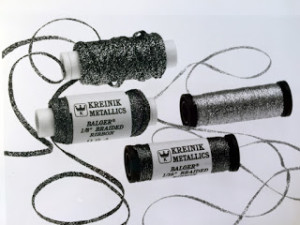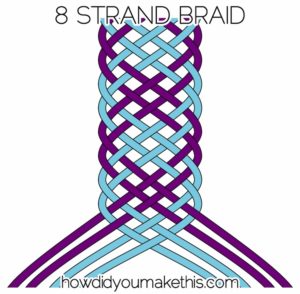
I you think about threads by construction (the most useful way) then you probably think of a “strand” as something you can easily pull out of a thread, as in embroidery floss.
When you can’t pull it out, then it is a “ply.”
Both these terms come from the process of making threads, in other words from spinning. Plies are individual spun strings of fiber that are twisted around each other during the spinning process to make strands.
The difference between your embroidery floss, which has six strands, and pearl cotton, which has one strand, is how it’s packaged, at least in this case. Both have individual strands made of plies.
This terminology does not apply to metallic threads.
That’s because metallic threads are not spun, they are braided. Metallics are made of extremely thin strips of metallic-colored polyester (essentially Mylar). These are combined with a non-metallic base thread. The whole bundle is then braided (yes, like hair) and made into the thread you use. The individual strips and threads that make up the braid are called strands. Even though the name is the same, these strands cannot be easily separated.

You can see this construction most easily in a flat metallic thread. Regular Fyre Werks is great for this. Take your needle and spread apart some of the thread. See how it looks like the flat braid pictured above?
The number of strand does give us the method to size metallic threads. Round metallic braids, such as Kreinik or Rainbow Gallery’s Treasure Braid, are sized by the number of strands in them. So a #4 braid has four strands but a #24 braid has 24.
This is, I think, only a relative number, I haven’t actually counted the strands.
Metallic ribbons are also braided but they are sized, if at all, by width.
In addition Kreinik also has names for their various sizes. They are:
- #4 Very Fine
- #8 Fine
- #12 Tapestry
- 316 Medium
- #24 Canvas
- #32 Heavy
Can I Use Multiple Strands as a Substitute?
Yes you can, up to a point. But three strands of #4 would stitch up thicker than one strand of #12.
At least part of the reason is that there is more air in the triple strand of #4 than in a single strand of #12.
I use two strands of #4 to substitute for #12. You should test to see if this works for you.
About Janet M Perry
Janet Perry is the Internet's leading authority on needlepoint. She designs, teaches and writes, getting raves from her fans for her innovative techniques, extensive knowledge and generous teaching style. A leading writer of stitch guides, she blogs here and lives on an island in the northeast corner of the SF Bay with her family

Leave a Reply